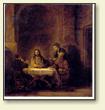| Relevant paintings: 
"Pilgrims at Emmaus," Rembrandt van Rijn 1648
[Enlarge]
|
Highlighting art - influences - Turn off highlighting
Dear Theo,
Very many thanks for the 50 francs and your letter.
You will be able to understand that I shall leave next
Tuesday if you consider, firstly, that I am simply longing for
it, secondly, that I risk getting stuck here with my work
through lack of models, while working out-of-doors has stopped
because of the cold.
As to my feeling the loss of a studio in Antwerp, yes, I
certainly shall. But I must choose between a studio without
work here, and work without a studio there.
I chose the latter. And I did it so gladly that it seems to
me like a return from exile. For I have been altogether out of
the painters' world for a long time. And meanwhile my power has
somewhat ripened, so that I feel more independent of the common
intrigues, which enables me to pitch certain fellows out. I
mean that in The Hague I was somewhat weaker with my brush than
the rest - I don't say in my drawing - and as they asked only
for painting and colour, I was more easily crushed than will
prove possible now.
As for Rubens, I am looking forward to him very much, but do
you object to my thinking Rubens's conception and sentiment of
his religious subjects theatrical, often even badly theatrical
in the worst sense of the word? Look here - take Rembrandt,
Michelangelo - take the “Penseroso” by
Michelangelo. It represents a thinker, doesn't it?
But his feet are small and swift, his hand has something of
the lightning quickness of a lion's claw and - that thinker is
at the same time a man of action, one sees that his thinking is
a concentration, but - in order to jump up and act in some way
or other. Rembrandt does it differently.
Especially his Christ in the “Men of Emmaus” is
more a soul in a body, which is surely different from a torso
by Michelangelo, but still - there is something powerful in the
gesture of persuasion.
Now put a Rubens beside it, one of the many figures of
meditative persons - and they become people who have retired
into a corner in order to further their digestion. That's how
it is in everything religious or philosophical he does, it is
flat and hollow; but what he can paint is - women
- like Boucher and better - there especially he gives one most
to think about and there he is at his deepest. What he can do -
combinations of colours - what he can do is - paint a queen, a
statesman, well analyzed, just as they are. But the
supernatural - where magic begins, no - unless putting
something infinite into a woman's expression, which, however,
is not dramatic.
I found a passage about Gainsborough which again stimulates
me to work with one stroke. Look here:
It is this brusqueness of touch that produces so much
effect. The spontaneity of his impression is all there, and
communicates itself to the spectator. For the rest Gainsborough
had a perfect method of ensuring the completeness of his
composition. He planned his picture all at once, and carried it
out harmoniously from top to bottom, without concentrating his
attention on separate little frag-ments, without obstinately
worrying over details, for he sought the general effect, and he
nearly always found it, thanks to his broad vision on the
canvas, which he looked at as one looks at nature, at a single
glance.
I shall send you the book by Ch. Blanc, etc., from Antwerp,
as soon as I can add a few studies.
As I don't know where I shall stay, I'll ask that when you
write on December 1, address your letter c/o G.P.O., unless I
let you know otherwise.
For I shall write again one of these days.
I found the enclosed sonnet by Jules Breton in a
magazine.
I repeat, as to my rather sudden departure from here, if I
hadn't had trouble with the models, I should have spent the
winter here. But working steadily with models here is not so
much hampered by the priest's opposition, which in itself would
have been neutralized by my ignoring it completely, but the
worst is that though I have the courage to stand my ground,
people hesitate, and are more frightened than I thought they
would be.
And I am not going to undertake it unless I am quite sure
that they have the courage. Now it might help if I go away for
a couple of months, and if it doesn't help, then not one of
those to whom I gave something for it every week last winter
will earn a penny with it this winter.
Goodbye,
Ever yours, Vincent
At this time, Vincent was 32 year oldSource:
Vincent van Gogh. Letter to Theo van Gogh. Written c. 18-22 November 1885 in Nuenen. Translated by Mrs. Johanna van Gogh-Bonger, edited by Robert Harrison, number 435.
URL: https://www.webexhibits.org/vangogh/letter/15/435.htm.
This letter may be freely used, in accordance with the terms of this site.
|